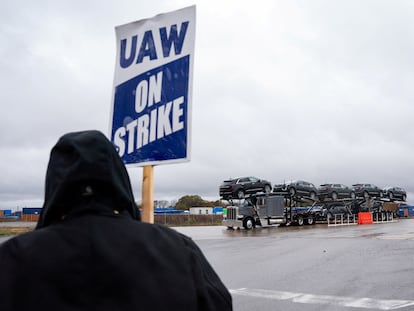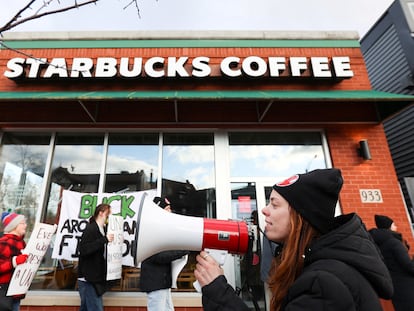General Motors, Ford and Stellantis workers ratify the agreement that ended the strike
The deal implies strong wage increases and other benefits for employees of the Big Three, and its effect has extended to other companies in the sector


The deal is final. With a little more trouble than expected, employees of Detroit’s Big Three (General Motors, Ford and Stellantis, which acquired Chrysler) have ratified the collective agreements that ended a historic auto industry strike in the United States, the first one to hit all three companies simultaneously. The agreements are similar to each other and in all three cases they include strong wage increases and other benefits.
The strike has been a success for the nearly 150,000 workers affiliated with the United Auto Workers (UAW) union in the three companies. These workers had been expelled from the middle class due to the loss of purchasing power accumulated for years, after making heavy sacrifices to save the companies in the midst of the Great Recession. The new agreements involve wage increases of more than 30% over the next four and a half years, along with other improvements in working conditions, guarantees and new rights.
The victory is not limited to General Motors, Ford and Stellantis. The agreements signed by the three companies have had a contagion effect on other automobile companies in the United States, but whose workers are not unionized. Toyota, Hyundai and Honda have approved immediate large pay raises for their employees.
Despite all the benefits that the new collective agreements incorporate, employees at several General Motors workplaces voted against the deal, which raised fears for the final result in the company as a whole. Finally, a vote tracking spreadsheet on the union’s website shows that, once data from all centers is included, the agreement was ratified with 19,683 votes in favor (54.74%) and 16,274 against. A union spokesperson confirmed to AP Thursday that the spreadsheet contained GM’s official totals.
In the case of Ford, although data from all centers has not yet been included, the tracking spreadsheet shows a two-thirds majority in favor of the deal, the same as at Stellantis. Although voting will continue at Ford through Saturday, only two large Detroit-area factories and a few smaller facilities remain to be counted. At Stellantis, the three big Detroit-area factories are the only ones that have not yet voted, and the recount is expected to end Tuesday. In both cases, ratification is taken for granted, although with more opposition than was achieved in other labor agreements this year, such as the truckers’ agreement with UPS or Hollywood screenwriters with the major studios.
The newest employees at all three companies are the greatest beneficiaries of the new agreements, a fact that has triggered some rejection at plants with a greater proportion of more senior employees. These have also achieved important improvements, but not as many as the new employees, who previously spent eight years penalized by a double wage tier and now will only be penalized for three years.
The president of the UAW, Shawn Fain, achieved the support of public opinion in a country not friendly to strikes, by brandishing the record profits of the companies and the multimillion-dollar salaries of their executives. He hit the companies with a carrot-and-stick strategy in which he rewarded or punished them depending on the progress of the negotiations.
Although there are variations between the different agreements, all of them include a 25% increase in hourly wages until April 2028, and with some adjustments for the cost of living it will be more than 30%, up to more than $40 dollars per hour for the typical worker. The agreements also include improvements in pensions and restrictions on temporary employment and recognize the right of workers to strike in protest against factory closures, among other workplace safety measures. The salary improvements of this agreement, the UAW has highlighted, are greater than those accumulated in the last 22 years.
Sign up for our weekly newsletter to get more English-language news coverage from EL PAÍS USA Edition
Tu suscripción se está usando en otro dispositivo
¿Quieres añadir otro usuario a tu suscripción?
Si continúas leyendo en este dispositivo, no se podrá leer en el otro.
FlechaTu suscripción se está usando en otro dispositivo y solo puedes acceder a EL PAÍS desde un dispositivo a la vez.
Si quieres compartir tu cuenta, cambia tu suscripción a la modalidad Premium, así podrás añadir otro usuario. Cada uno accederá con su propia cuenta de email, lo que os permitirá personalizar vuestra experiencia en EL PAÍS.
¿Tienes una suscripción de empresa? Accede aquí para contratar más cuentas.
En el caso de no saber quién está usando tu cuenta, te recomendamos cambiar tu contraseña aquí.
Si decides continuar compartiendo tu cuenta, este mensaje se mostrará en tu dispositivo y en el de la otra persona que está usando tu cuenta de forma indefinida, afectando a tu experiencia de lectura. Puedes consultar aquí los términos y condiciones de la suscripción digital.
More information
Archived In
Últimas noticias
Most viewed
- Oona Chaplin: ‘I told James Cameron that I was living in a treehouse and starting a permaculture project with a friend’
- Reinhard Genzel, Nobel laureate in physics: ‘One-minute videos will never give you the truth’
- Sinaloa Cartel war is taking its toll on Los Chapitos
- Why the price of coffee has skyrocketed: from Brazilian plantations to specialty coffee houses
- Silver prices are going crazy: This is what’s fueling the rally










































